Traveling Light: My 2 Speedlight Portrait Setup
I have recently added a second speedlight to my out-of-the-studio kit with the plan of being able to travel a bit lighter and more efficient. In the past I would bring along a monoilght for off-camera lighting at events, but now the second speedlight negates that need.
Today's portrait of Pastor Steve at last weekend's wedding shoot was captured with this two-speedlight setup. I had a Canon 580EXII on my camera with a 430EX on a lightstand with an umbrella to the right. The two strobes communicated with each other via IR. I set the on-camera strobe at -2/3 f/stop to serve as a fill light and set the off-camera strobe at +1/3 f/stop to be my main light. I then put my camera on manual with an exposure of 1/60 second at f/5.6. The TTL (through-the-lens) function of the speedlights managed their power output.
As you can see from the image, this setup worked well. The biggest advantage over using a monolight was that I didn't have to re-meter anytime I moved the off-camera light. The TTL adjusted the power output to my exposure. I could move the off-camera light back for larger groups and in for individuals without worrying about exposure changes. And, unlike my monolights, I was able to operate cord-free since the lights are battery powered.
Even though this setup works well, I think that in the future I will add one more Speedlight to add even more versatility.
Canon 5D, Canon 24-105 f/4L lens - 1/60 second, f/5.6, ISO 100
Labels: tutorial




4 Comments:
completely love my iTTL setup too - although I'm on the Nikon side of the force. I remember going into Pictureline and a guy showed me iTTL with a D70 and an SB800 - two months later I up-to-my-neck back into photography. The coolest technology for just the reasons you mention here.
However, the Nikon flashes talk via light bursts, are you sure Canon is talking through IR?
I set my camera on a 6 second exposure, rear-curtain, and it flashed once before the shutter opened (I'm guessing to measure the light) and then again at the end of the exposure for the rear-curtain. I thought Canon worked the same way -
It's a great photo, I appreciate your blog. Inspiring and I've learned a thing or two. Thanks!
@digital knight
Yes, the Canon Speedlights use an infrared pulse for communication. I have no experience with the Nikon units, but I thought they also communicated this way.
Yes, both Canon and Nikon flashes work the same way, with pulses of light (though IR will do as in the case of the ST-E2).
One thing both of you might want to consider... I recently purchased a pair of Radio Poppers (you need both a transmitter and a receiver).
Radio Popper transmitters turn your flash's light pulses into radio signals and transmit them to the receiver. The receiver then turns the radio signal back into the light pulses that your slave flash can understand. Effectively extending both the range and versatility of your flash (you can use it around corners, you can use it in bright sunlight). Pretty cool really!
I love using ETTL when "on the road". It saves carrying a ton of equipment and I can shoot a lot faster with ETTL by not having to manage my flash exposure (set for the background, let ETTL figure out the rest).
Check them out:
http://www.radiopopper.com/
Did you use a diffuser on both Speedlights? Was the off camera flash to the subjects right?
Post a Comment
<< Home